

The Republic of Czechoslovakia, founded at the end of World War I, was part of the old Austrian-Hungarian Empire. It had an area of 49,371 sq. mi. (127,870 sq. km.) and a population of 15.6 million. Capital: Prague (Praha).
Czechoslovakia proclaimed itself a republic on Oct. 28, 1918, with Tomas G. Masaryk as President. Hitler’s rise to power in Germany provoked Czechoslovakia’s German minority in the Sudetenland to agitate for autonomy. At Munich (Munchen) in Sept. of 1938, France and Britain, seeking to avoid World War II, forced the cession of the Sudetenland to Germany. In March, 1939, Germany invaded Czechoslovakia and established the “protectorate of Bohemia and Moravia”. Bohemia is a historic province in northwest Czechoslovakia that includes the city of Prague, one of the oldest continually occupied sites in Europe. Moravia is an area of considerable mineral wealth in central Czechoslovakia. Slovakia, a province in southeastern Czechoslovakia under Nazi influence was constituted as a republic. The end of World War II saw the re-established independence of Czechoslovakia, while bringing it within the Russian sphere of influence. On Feb. 23-25, 1948, the Communists seized control of the government in a coup d’etat, and adopted a constitution making the country a ‘people’s republic’. A new constitution adopted June 11, 1960, converted the country into a ‘socialist republic’, which lasted until 1989. On Nov. 11, 1989, demonstrations against the communist government began and in Dec. of that same year, communism was overthrown, and the Czech and Slovak Federal Republic was formed. In 1993 the CSFR split into the Czech Republic and The Republic of Slovakia.
NOTE: The term “VZ” stands for model (Vzor) in Czech. This abbreviation is used in place of the English word Model. The author has sometimes used both terms but never together.
Most Czech handguns are of Czech design and manufacture. See below.
Army Pistole 1922
Semi-automatic pistol chambered for the .380 ACP (9×17mm short) cartridge. Barrel length is 3.5 inches. Magazine capacity is 8 rounds. Weight is approximately 22 oz. Adopted by the Czech army in 1922 and called the M22. This was the first Czech designed and manufactured service semi-automatic pistol. It was based on a German locked breech design and made under license from Mauser. Blued with checkered plastic grips. Manufactured between 1921 and 1923. Because of production difficulties, only about 22,000 were built.
Exc. |
V.G. |
Good |
Fair |
700 |
550 |
350 |
200 |
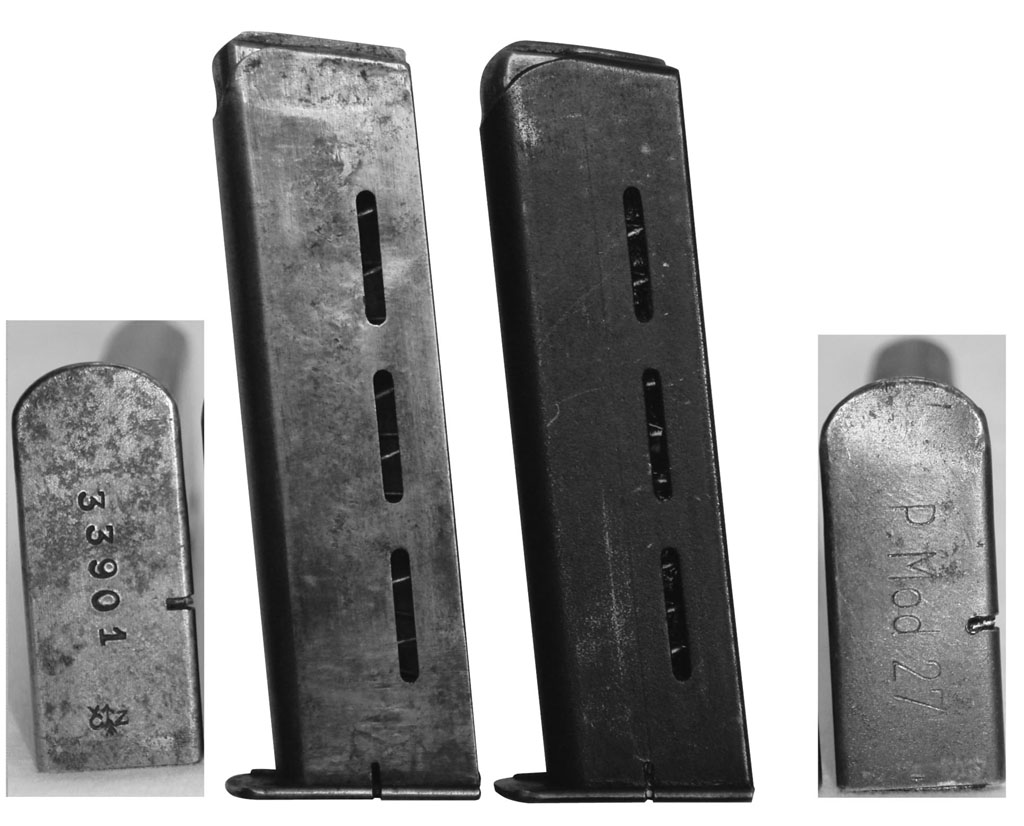
CZ M1922 magazine (l) and CZ 1927 magazine marked “P Mod 27” (r). • Price 70-30


CZ 1924 • Courtesy Orvel Reichert
CZ 1924
The first large production military pistol produced by CZ. It is a locked-breech pistol with a 3.5" rotating barrel chambered for the 9mm short cartridge, external hammer, and a magazine safety. It features a rounded slide and is blued with a wrap-around walnut grip. Magazine capacity is 8 rounds. The slide is marked “Ceska Zbrojovka A.S. v Praze.” Weight is approximately 24 oz. About 170,000 of these pistols were produced between 1922 and 1938.
NOTE: A limited number of pistols have been noted marked “CZ 1925” and “CZ 1926.” There are various minor design changes on each model, and it is conjectured that they were prototypes that were manufactured on the road to the production of the less complicated, blowback-operated CZ 1927 pistol.
Exc. |
V.G. |
Good |
Fair |
700 |
475 |
300 |
200 |
NOTE: For Nazi-proofed add 50 percent.
CZ 1927
A semi-automatic pistol chambered for the 7.65mm cartridge (.32 ACP), marked the same as the CZ 1924, but the cocking grooves on the slide are cut vertically instead of sloped as on the earlier model. This model was blued with checkered, wrap-around, plastic grips. These early guns were beautifully made and marked “CESKA ZBROJOVKA AS V PRAZE.”
This version remained in production during the German occupation of Czechoslovakia between 1939 and 1945. Occupation pistols are marked, “BOHMISCHE WAFFENFABRIK IM PRAG.” The Germans used the code “fnh” on these wartime pistols and designated the model the “Pistole Mod 27(t).” The finish declined as the war progressed, with the very late guns rough but functional. There are several subvariations of this pistol that may affect value. A total of about 450,000 were produced during the German occupation. After the war, these pistols continued in production until 1951. There were almost 700,000 manufactured.

Early CZ 27 with Nazi production markings • Courtesy Orvel Reichert

Early CZ 27 with Nazi production markings • Courtesy Orvel Reichert
Exc. |
V.G. |
Good |
Fair |
500 |
375 |
250 |
200 |
NOTE: For Nazi-proofed add 25 percent.
NOTE: Some of these pistols were made with an extended barrel for the use of a silencer. This variation brings a large premium. Fewer than 10 CZ 27s were made in .22 caliber.

CZ 27 with silencer • Courtesy Orvel Reichert
Holster for CZ-27
WWII vintage leather construction. Magazine pouch on front. Wide belt loop on back. Black or brown. Some have Nazi markings on the inside of the flap. Add 50% for Nazi markings.
Exc. |
V.G. |
Good |
Fair |
100 |
75 |
50 |
25 |

Holster for CZ-27
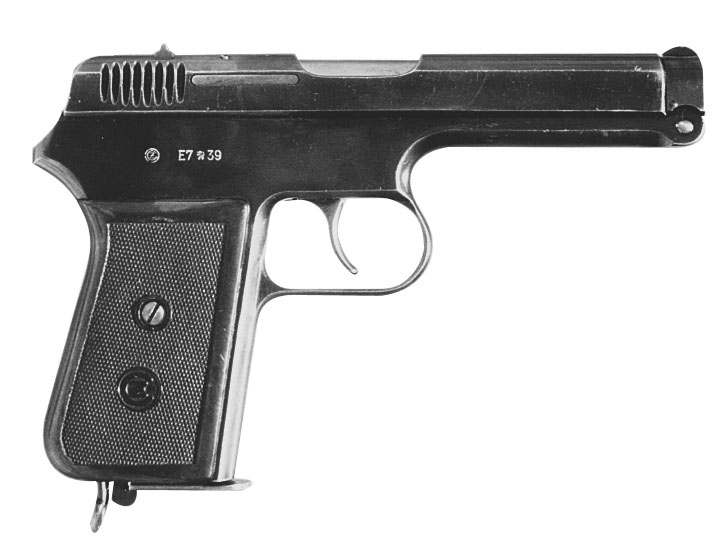

Wartime CZ 27 with Nazi production markings • Courtesy Orvel Reichert
CZ 1938
It is chambered for the 9mm short cartridge (.380 Auto) and has a 4.65-inch barrel. Except for a few examples with a conventional sear and slide safety, it is double action-only with exposed hammer, and difficult to fire accurately. It utilizes a 9-round, detachable box magazine; and the slide is hinged at the muzzle to pivot upward for ease of cleaning and disassembly. It is well made and well finished, but is as large in size as most 9mm Parabellum pistols. Production began in 1938, and the Germans adopted it as the “Pistole Mod 39” on paper; but it is doubtful that any were actually used by the German army. It now appears that the P39(t), which is the Nazi designation, were all sent to Finland and a large number with “SA” (Finnish) markings have recently been surplused along with their holsters. A few SA marked guns have been modified by the Finnish army to function single or double action. About 40,000 of these pistols were manufactured.
Exc. |
V.G. |
Good |
Fair |
800 |
600 |
450 |
250 |
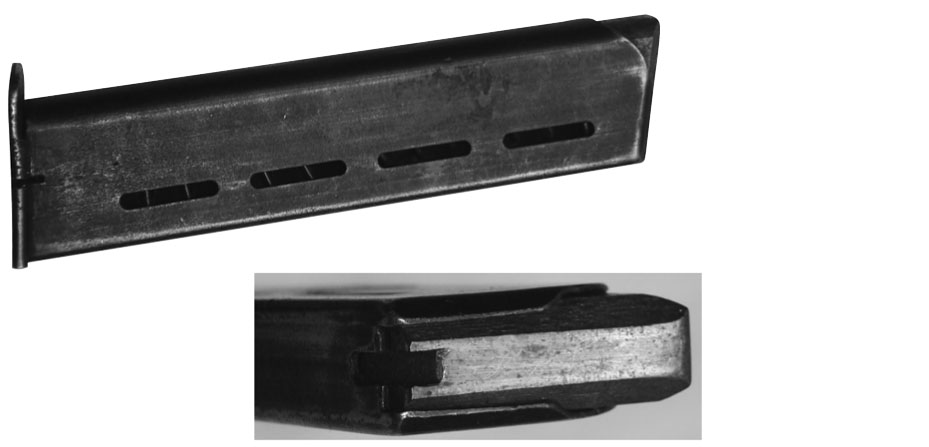
CZ M1938 Magazine, 9 rounds of 9mmK (.380). • Price 75-40
CZ 1938 Nazi-Proofed (P39[t])
Fewer than 1,000 of these pistols were Nazi-proofed late in the war. E/WaA76 acceptance stamp on left frame and barrel.
Exc. |
V.G. |
Good |
Fair |
2000 |
1600 |
1250 |
600 |
CZ 1950
This is a blowback-operated, semi-automatic, double action pistol chambered for the 7.65mm cartridge with a 3.75-model barrel. Magazine capacity is 8 rounds. Weight is about 23 oz. It is patterned after the Walther Model PP with a few differences. The safety catch is located on the frame instead of the slide; and the triggerguard is not hinged, as on the Walther. It is dismantled by means of a catch on the side of the frame. Although intended to be a military pistol designed by the Kratochvil brothers, it proved to be underpowered and was adopted by the police. There were few released on the commercial market.

CZ 1950 • Courtesy Chuck Karwan
Exc. |
V.G. |
Good |
Fair |
300 |
200 |
150 |
100 |
Model 1970
This model was an attempt to correct dependability problems with the Model 50. There is little difference to see externally between the two except for markings and the grip pattern. Markings are “VZOR 70 CAL 7.65.” Production began during the 1960s and ended in 1983.

CZ M1970 • Courtesy Rock Island Auction Company
Exc. |
V.G. |
Good |
Fair |
275 |
200 |
150 |
100 |
CZ 1952
Since the Czechoslovakian army was not happy with the underpowered CZ 1950 pistol, they began using Soviet weapons until 1952, when this model was designed. It was designed for a new cartridge known as the 7.62mm M48. It was similar to the Soviet cartridge but loaded to a higher velocity. This is a single action, semi-automatic pistol with a 4.5-inch barrel. It has a locked breech that utilizes two roller cams. Magazine capacity is 8 rounds. Many refurbished and original pistols were imported into the U.S. beginning around 2004.

Exc. |
V.G. |
Good |
Fair |
400 |
275 |
200 |
100 |
CZ 75
Introduced in 1975. 4.5-inch barrel. 9mm 15 round magazine. Offered in both commercial and military versions the CZ 75 is used by more than 60 countries around the world in 9mm. Approximately 1,250,000 military pistols are in service. The Czechs use the pistol in their Special Forces units. The CZ-75 was banned from import to the U.S. until 1994 when the U.S. relaxed the ban on imports of firearms from former communist countries. A few early commercial models were imported by law enforcement officers before 1994, thanks to an exception in the import rules. These brought a premium price at the time. Frequently in the 700-800 range. The popularity of the CZ-75 design inspired copies to be made in Switzerland, Italy and Israel. These were imported to the U.S. beginning in the mid 1980s. To the author’s knowledge, no military issue CZ-75s have appeared on the U.S. market. Price for current commercial CZ-75B, basic model. Black finish, fixed sights. Many options and finishes are available.
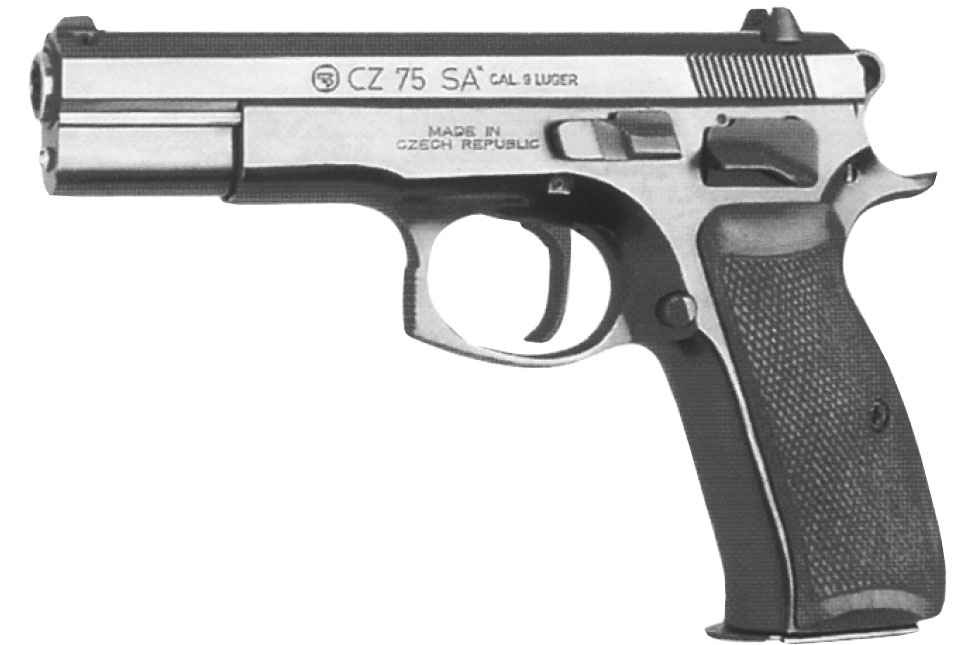
Exc. |
V.G. |
Good |
Fair |
575 |
475 |
350 |
N/A |
CZ 82/83
This is a fixed-barrel .380 caliber pistol. It features an ambidextrous safety and magazine catch behind the triggerguard. The pistol is stripped by means of a hinged triggerguard. Barrel length is 3.8 inches, overall length is 6.8 inches, and weight is about 23 oz.
The Model 82 designation is the military model, while the Model 83 is the commercial version. The Model 83 is offered in two calibers: 9×18 Makarov, and .380. The military Model 82 is offered in only one caliber, the 9mm Makarov. The Model 82 is the side arm of the Czech army. The Model 82 is no longer in production, but the Model 83 is currently manufactured.
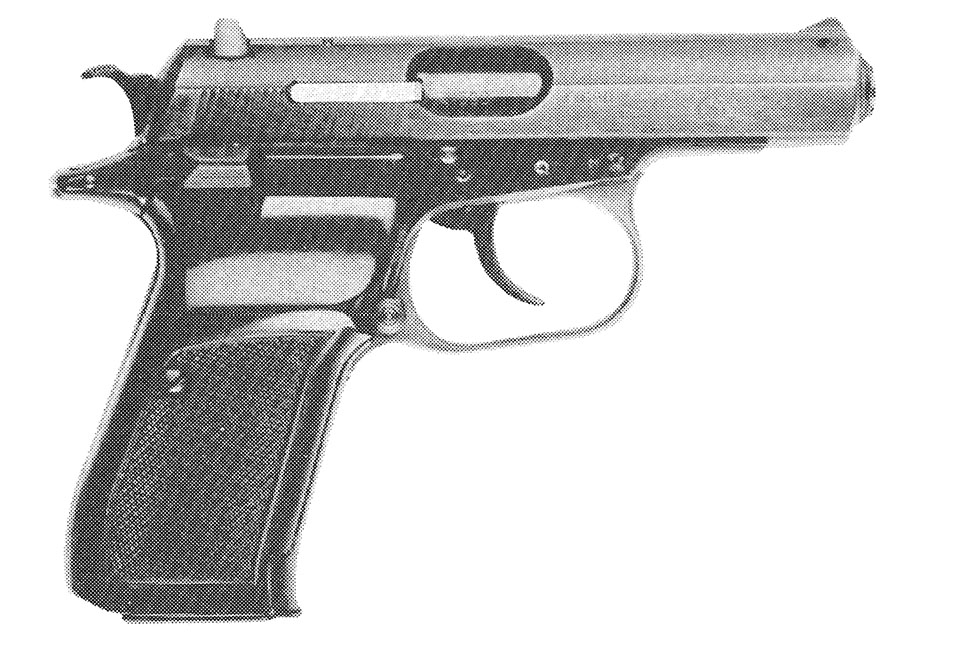
Exc. |
V.G. |
Good |
Fair |
375 |
275 |
225 |
150 |
The Czechs built the CZ 247 and the CZ 47 after World War II, but did not adopt these guns for their own military use. Instead they were exported to South America and other countries. These submachine guns are chambered for the 9mm Parabellum cartridge and are similar in appearance to the CZ 1938 gun but with a 40-round magazine.
CZ 23/25
The Model 23 has a wooden stock while the Model 25 has a folding metal stock; otherwise all other dimensions are the same. Introduced in 1948, this submachine gun is chambered for the 9mm cartridge. Magazine capacity is 25- or 40-round box type. Rate of fire is about 600 rounds per minute. Weight is approximately 8 to 8.5 lbs., depending on model. This gun introduced the hollow bolt that allows for the short length of the gun (17.5 inches with butt folded, 27 inches with butt extended) and was copied in the Uzi. The magazine well is located in the pistol grip, another feature copied by the UZI. The trigger mechanism is designed so that light pressure gives semi-automatic fire while full trigger pressure gives full automatic fire. Weight of the gun is about 7 lbs. A variation of this model is called the Model 24/26 and is the same except for the caliber: 7.62mm.

Courtesy Thomas Nelson, The World’s Submachine Guns, Vol. 1
NOTE: Prices listed are estimates only.
Pre-1968
Exc. |
V.G. |
Fair |
12500 |
11000 |
10000 |
ZK 383
This submachine gun was first introduced in 1933. It is chambered for the 9mm Parabellum cartridge and fitted with a 12.8-inch quick change barrel with jacket. Adjustable rate of fire from 500 to 700 rounds per minute by means of a removable insert in the bolt. This model was fitted with a bipod. Rear sight is a V-notch tangent graduated to 800 meters. Weight is about 9.5 lbs. This gun was sold to Bulgaria, some South American countries, and was used by the German army from 1938 to 1945.

ZK 383 • Courtesy Thomas Nelson, The World’s Submachine Guns, Vol. 1
A variation of this model called the ZK 383P was used by police units and does not have a bipod or quick change barrel. The ZK 383H was a limited production version with a folding magazine housing fitted to the bottom of the gun rather than the side.
Pre-1968
Exc. |
V.G. |
Fair |
14000 |
13000 |
12000 |
Skorpion Samopal VZ61
Introduced in 1960 this weapon is sometimes referred to as a machine pistol because of its size. Chambered for the 7.65×17SR Browning (.32 ACP) cartridge. Export models of this gun are chambered for the 9×17mm (.380 ACP[VZ63]), 9×18mm Makarov (VZ64), and the 9×19mm Parabellum (VZ68). The gun has a 4.5-inch barrel and is fitted with a wooden pistol grip. Overall length with butt folded is 10.5 inches; with butt extended 20.5 inches. Weight is approximately 3 lbs. Rate of fire is about 700 rounds per minute. A licensed copy made in Yugoslavia is called the Model 84. No transferable examples known.
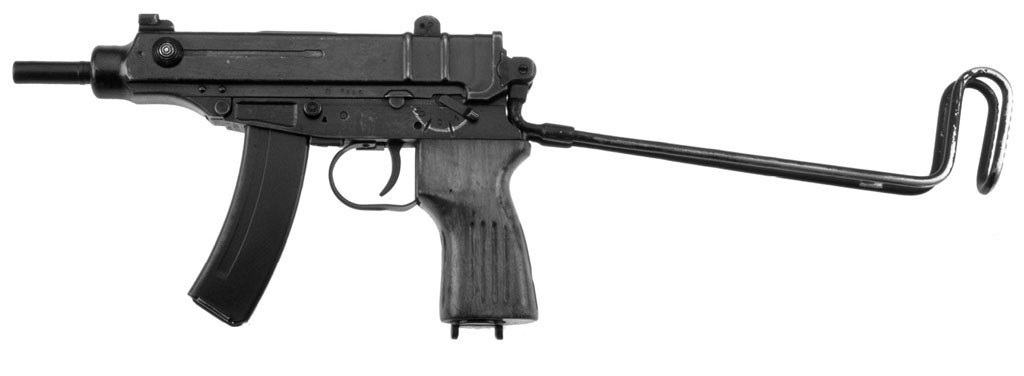
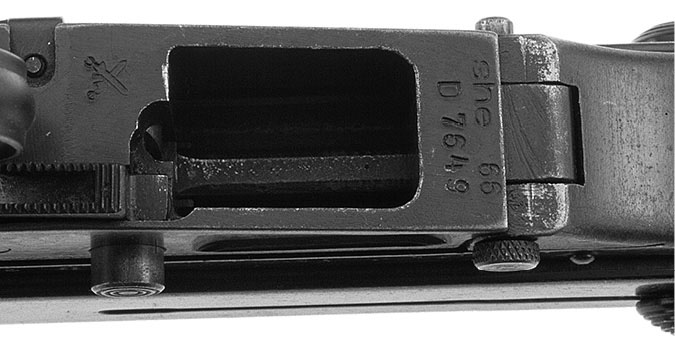
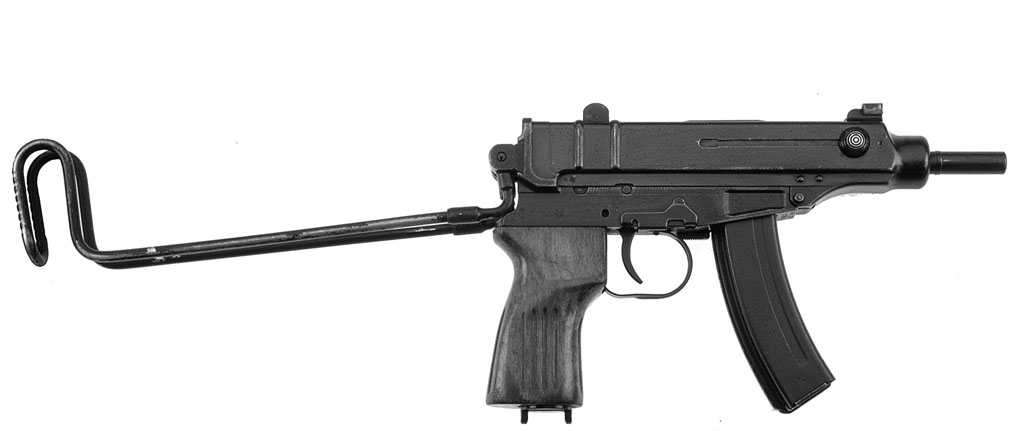
Skorpion • Courtesy West Point Museum, Paul Goodwin photo
Pre-1968
Exc. |
V.G. |
Fair |
N/A |
N/A |
N/A |
CZ USA Vz 61 Skorpion semi-automatic handgun
New commercial production semi automatic version of the Vz-61 using some original parts as well as American made parts. Cal. 7.65mm/.32 automatic. 4.5-inch barrel.
Exc. |
V.G. |
Good |
Fair |
800 |
700 |
500 |
N/A |
Immediately after WWI the Czechs continued to use the Mannlicher Model 1895 rifle until 1924 when they began production of their own Mauser action rifles.
Ceskoslovensha Zbrojovaka (ZB), Brno
NOTE: In 1924 the Czechs began to manufacture a number of Mauser-designed rifles for export, and for its own military use. Czech Mausers were based on the Model 98 action. Many of these rifles were sold to other countries and will be found under Germany, Mauser, Rifles.
NOTE: Prices are for rifles with matching numbers and original markings. Most recent imports have mismatched bolts. Many have receiver markings ground off. Deduct 50 percent for mismatch or recent ground imports.
M1898/22 Rifle
Manufactured by CZ in Brno this rifle is based on the Mexican Model 1912 with a Model 98 action. It is half stocked with a full-length upper handguard with pistol grip. Chambered for the 7.92×57mm Mauser cartridge. Barrel length is 29 inches with a 5-round integral magazine. Weight is about 9.5 lbs. This rifle was used by Turkey as well as other countries.

Courtesy Rock Island Auction Company
Exc. |
V.G. |
Good |
Fair |
600 |
400 |
250 |
150 |
VZ23 Short Rifle
Used by the Czech army this 7.92×57mm rifle was fitted with a 21.5-inch barrel and 5-round magazine. Tangent leaf rear sight graduated to 2,000 meters. Most were marked, “CZECHOSLOVAKIAN FACTORY FOR ARMS MANUFACTURE, BRNO” on the receiver ring. Weight is about 9 lbs.
Exc. |
V.G. |
Good |
Fair |
800 |
600 |
350 |
175 |
VZ12/33 Carbine
This rifle was produced primarily for export. It has a pistol grip stock with ¾-length upper handguard and two barrel bands fairly close together. Bolt handle is bent down. Barrel length is 21.5-inch with 5-round magazine. Rear leaf sight is graduated to 1,400 meters. Weight is about 8 lbs. Country crest stamped on receiver.
Exc. |
V.G. |
Good |
Fair |
850 |
650 |
400 |
250 |
VZ16/33 Carbine
Designed for paramilitary units this rifle has a 19.25-inch barrel. Chambered for the 7.92×57mm cartridge as well as other calibers depending on country. Magazine capacity is 5 rounds. Tangent rear leaf sight graduated to 1,000 meters. Czech crest stamped on receiver ring. This rifle formed the basis on the German Model 33/40 paratroop carbine used during WWII.

Courtesy Cherry’s Fine Guns
Exc. |
V.G. |
Good |
Fair |
950 |
800 |
650 |
300 |
Ceskoslovenska Zbrojovka Brno (BRNO) was established in 1919 as the state arms factory. It was originally state owned but later, in 1924, was reorganized as a limited liability company.
M1895
The Czechs built about 5,000 of these Mannlicher rifles.
Exc. |
V.G. |
Good |
Fair |
600 |
400 |
250 |
150 |
Model 24 (VZ24)
This rifle marks the first Czech produced military rifle for the Czech army. It was based on the Mauser 98 action. The rifle was in wide use by other countries such as Germany prior to WWII. Chambered for the 7.92mm cartridge and fitted with a 23-inch barrel, this model had a 5-round non-detachable box magazine. The rear sight was graduated from 300 to 2,000 meters in 100 meter increments. Weight is about 9 lbs.
Exc. |
V.G. |
Good |
Fair |
650 |
450 |
275 |
150 |
Bayonet for Czech VZ 24 and other Mausers
Wood handle. 11.75-inch single edge blade. The cutting edge is to the top. Most have a muzzle ring, but these were sometimes removed. Cross piece has two rivets. Marked on the blade “CSZ” and possibly a Czech lion and date. Price range 60 – 20.


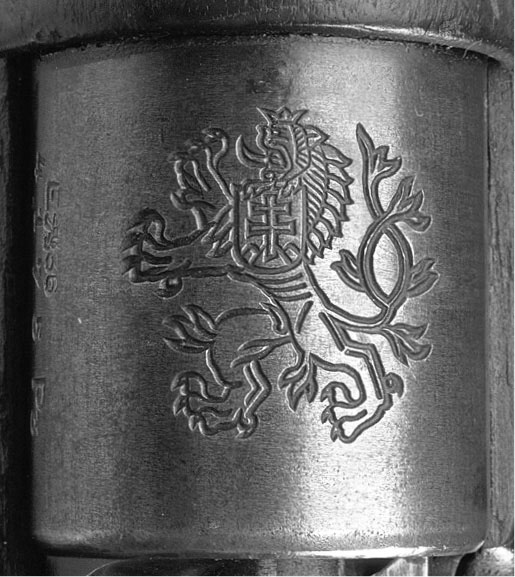
Czech VZ24 with receiver markings and crest • Paul Goodwin photo

Bayonet for Czech VZ24
Model ZH29
Introduced in 1929, this semi-automatic rifle was designed by Emmanuel Holek of CZ at Brno. It is chambered for the 7.92×57mm cartridge and is fitted with a 21.5-inch barrel with aluminum cooling jacket. Fitted with a bayonet lug. The detachable box magazine has a 10- or 25-round capacity. Weight is about 10 lbs. Exported to Thailand and Ethiopia. Very rare.

Courtesy Thomas Nelson, The World’s Submachine Guns, Vol. 1
Exc. |
V.G. |
Good |
Fair |
13500 |
10500 |
7500 |
— |
Model ZK420S
Chambered for the 7.92×57mm cartridge this rifle was first introduced in 1942 but did not appear in its final form until 1946. It was also offered in 7mm, .30-06, and 7.5mm Swiss. This was a gas operated semi-automatic rifle with 21-inch barrel and upper handguard. The detachable magazine has a 10-round capacity. Front sight is hooded. Rear sight is notched tangent with ramp. Weight is about 10 lbs. Not adopted by Czech military but tested by many countries. Built by CZ Brno in limited numbers. Very rare.
Exc. |
V.G. |
Good |
Fair |
10500 |
9000 |
8000 |
— |
Model 52
Chambered for 7.62×45 caliber, this gas operated semi-automatic rifle is fitted with a 20.5-inch barrel. This model has a full stock with pistol grip. Folding non-detachable bayonet. Hooded front sight and notched tangent rear sight with ramp. Detachable box magazine with 10-round capacity. Weight is about 9.7 lbs. First produced in 1952.
Exc. |
V.G. |
Good |
Fair |
500 |
400 |
350 |
275 |
Model 52/57
Similar to the Model 52 except chambered for the 7.62×39 cartridge.

Courtesy Thomas Nelson, The World’s Submachine Guns, Vol. 1
Exc. |
V.G. |
Good |
Fair |
750 |
600 |
450 |
300 |
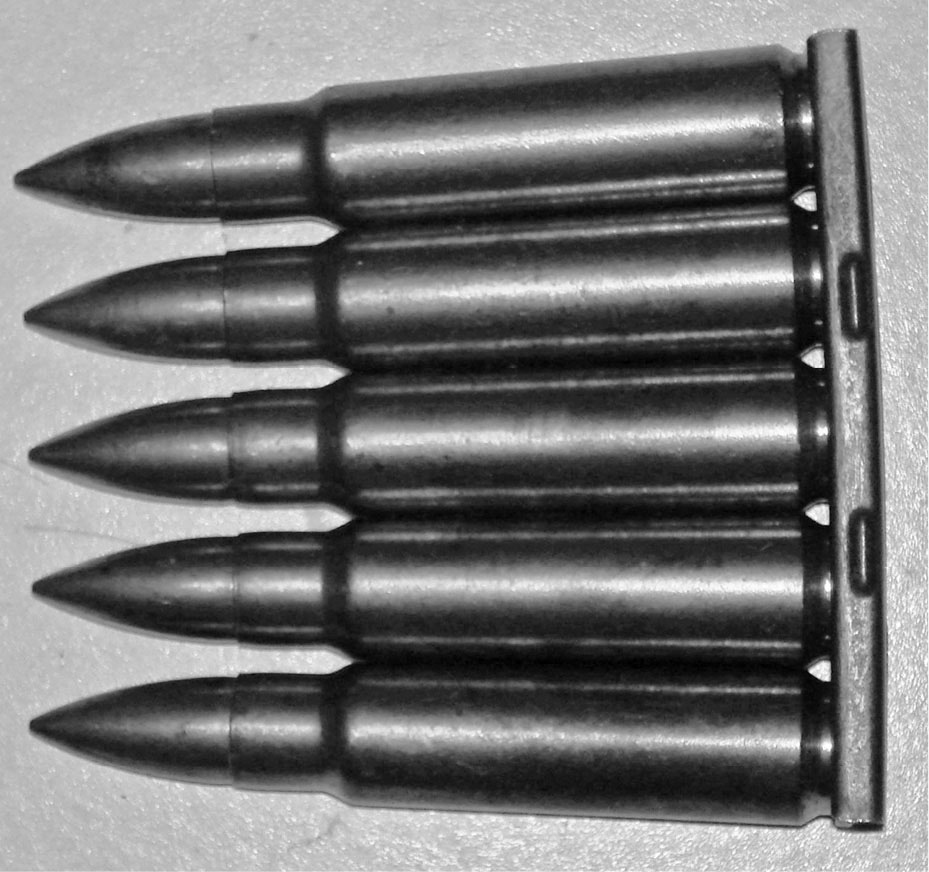
Model 1957 Sniper Rifle
This rifle, introduced in 1954, is built on a Mosin Nagant 1891/30 action and fitted with a 28.7-inch barrel chambered for the 7.62×54mmR cartridge. Magazine capacity is 5 rounds. Half stock with pistol grip and handguard. Rifle is supplied with a 2.5× telescope. Weight is approximately 9.5 lbs. Built by CZ in Brno. Production ended in 1957. Deduct 50 percent if there is no scope.
Exc. |
V.G. |
Good |
Fair |
1500 |
1200 |
850 |
600 |
VZ58
First produced in 1959, this select fire assault rifle is chambered for the 7.62×39mm Soviet cartridge. Its appearance is similar to an AK-47 but it is an entirely different design. It is gas operated but the bolt is locked to the receiver by a vertically moving block similar to the Walther P-38 pistol. Early rifles were fitted with a plastic fixed stock while later rifles used a folding metal stock. Barrel length is 16-inch. Rate of fire is about 800 rounds per minute. Weight is approximately 7 lbs. Production ceased in 1980. Made at CZ Brno and Povaske Strojarne. The two versions of this gun are designated the VZ58P with fixed stock and the VZ58V for metal folding stock.
Pre-1968
Exc. |
V.G. |
Fair |
18000 |
15000 |
12000 |
VZ 58 Military Sporter, semi-automatic
Limited importation by CZ USA. Offered with standard or folding stock.
Exc. |
V.G. |
Good |
Fair |
1200 |
950 |
800 |
N/A |


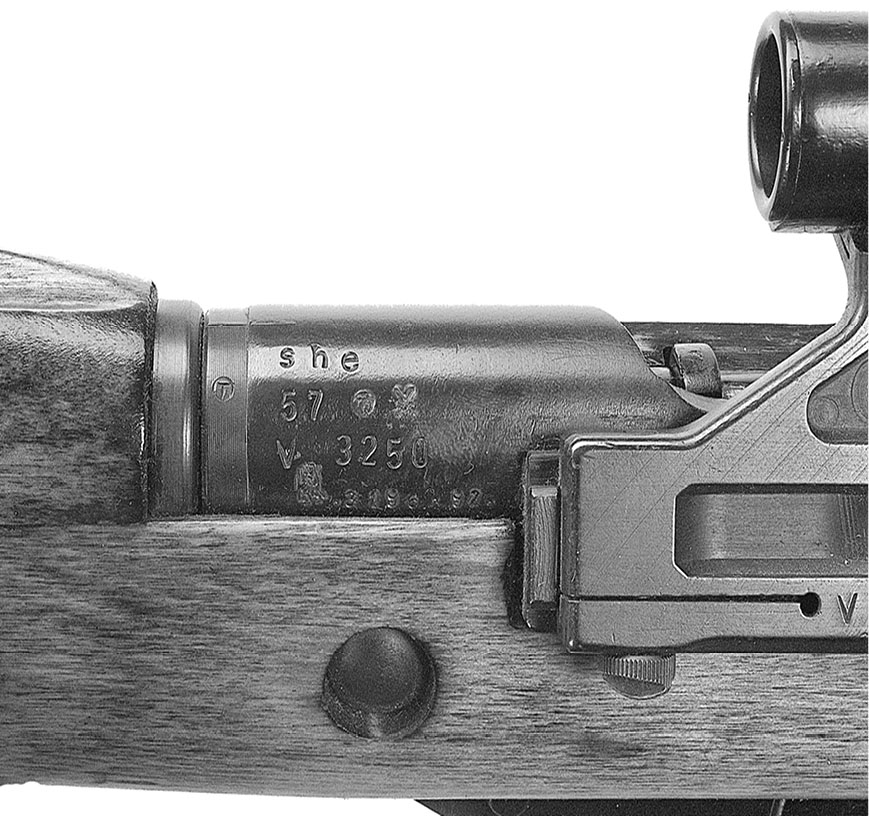
VZ57 Sniper with receiver markings • Private Collection, Paul Goodwin photo


VZ58 with receiver markings • Courtesy West Point Museum, Paul Goodwin photo
VZ 58 semi-automatic (new production)
Limited production by Ohio Ordnance Works. Built from original parts on a U.S.-made semi-automatic receiver.
Exc. |
V.G. |
Good |
1500 |
1250 |
N/A |
VZ 2008 semi-automatic (new production)
Limited production Century Arms. Built from original VZ-58 parts on a U.S.-made semi-automatic receiver.
Exc. |
V.G. |
Good |
1000 |
750 |
550 |
The Czechs used the Steyr-built Schwarzlose Model 7/24 adopted to 7.92mm immediately after World War I. Czechoslovakia has also used the Soviet SG43 and the Soviet DT. Today the Czech army uses the ZB 59 as its primary machine gun. The ZB 59 is called a universal machine gun when mounted on a bipod. It is also used by the Czech military with a light barrel.
ZB VZ26
Manufactured by CZ Brno, this weapon is a light air-cooled gas-operated select-fire machine gun chambered for the 7.92×57mm Mauser cartridge. Fitted with a 23.7-inch finned barrel, it has a rate of fire of 500 rounds per minute. It is fed by a 20- or 30-round box magazine. Bipod and carry handle standard. Wooden butt with pistol grip. Quick change barrel. It was adopted by over two dozen countries around the world. It was the forerunner of the famous British Bren gun (model designation ZGB33). Produced from 1925 to 1945. On left side of receiver marked “brno,” and on right side marked “LEHKY KULOMET ZB VZ26.” Weight is about 21 lbs. This gun was, and still is, used in large numbers throughout the world.
ZB made small improvements to the VZ26 along with the date of the improvements. These guns are essentially the same as the ZB 26, but are known as the ZB VZ27 and VZ28.


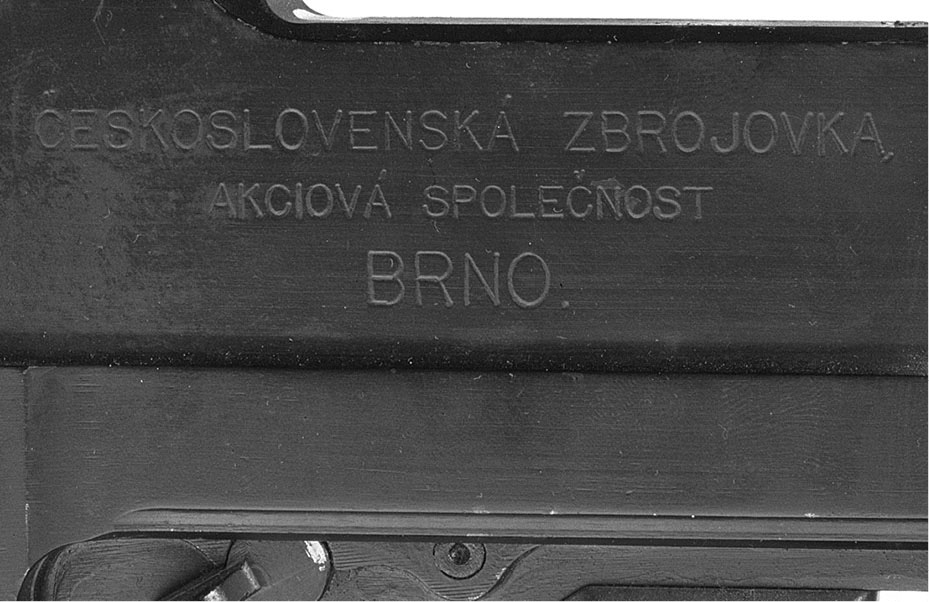
ZB VZ26 with both left and right side receiver markings • Paul Goodwin photo
Pre-1968
Exc. |
V.G. |
Fair |
35000 |
32500 |
30000 |
Pre-1986 manufacture with new receiver or re-weld
Exc. |
V.G. |
Fair |
25000 |
23000 |
20000 |
ZB VZ30
This weapon has an outward appearance almost identical to that of the VZ26 but with the exception of a new bolt movement design different from the VZ26. It has a 26.5" finned barrel and uses a 30-round top mounted straight box magazine. The rate of fire is about 600 rounds per minute. Weight of the gun is approximately 21 lbs. This model was adopted by China, Spain, and Iran. Between 1939 and 1945 it was also used by the German army. A variation of the ZB VZ30 is the ZB VZ30J (Yugoslavian or Venezuelan) similar to the VZ30 but with a heavy knurled portion of the barrel at the breech end.
Pre-1968
Exc. |
V.G. |
Fair |
20000 |
18500 |
17000 |
ZGB VZ30 (VZ32/33/34)
Same as the VZ30 but modified to fire the British .303 cartridge. Uses a curved 20-round magazine to accommodate the .303 cartridge. Improved versions of this gun are known as the VZ32, the VZ33, and the VZ34. These later versions use a 30-round magazine and a slightly shorter barrel. Reduced rate of fire to 500 rounds per minute.
Pre-1968
Exc. |
V.G. |
Fair |
25000 |
20000 |
18000 |
ZB VZ37 (Model 53 for export)
Introduced in 1937 this gun was designed as a medium air-cooled machine gun chambered for the 7.92×57mm cartridge. The finned barrel was 26.5 inches in length. Uses a 100- or 200-round metal belt. Grips mounted under the receiver with trigger. Rate of fire was either 500 or 700 rounds per minute. Weight is approximately 40 lbs. This gun is usually tripod mounted. A number of these guns were supplied to Viet Cong and North Vietnamese forces during the 1960s. Some 4,000 were sold to Israel in 1949. Many more were exported to the Middle East and Africa.
Pre-1968 (Very Rare)
Exc. |
V.G. |
Fair |
30000 |
25000 |
22000 |
ZB 39
In 1939 the Czechs exported a small number (est. fewer than 100) of this gun to Bulgaria in 8×56R Austrian Mannlicher caliber. This gun is stamped with the Bulgarian crest and other markings. The gun is fitted with a forward sling swivel, a ring-mounted extension around the wrist of the stock, and a different compact sight mounting system is used. Some examples are found in .303 caliber and it is thought that these examples come from South Africa.

VZ39 Export Gun • Courtesy Robert E. Naess
Pre-1968
Extremely rare; only one transferable example known.
VZ52/57
This gun is based on the ZB VZ30. It is chambered for the 7.62×39 rimless cartridge (Warsaw Pact). The gun was originally chambered for the 7.62×45 rimless cartridge (VZ52). Barrel length is 27 inches and is quick-change. It is fed by a 100-round belt or 25-round detachable box magazine. Rate of fire is 900 rounds per minute with box magazine and about 1,100 rounds per minute with belt. Weight is about 17.5 lbs. with bipod. This is a select-fire weapon with the finger pressure on the trigger determining full auto or single-round fire. The gun was introduced in 1952. This gun is often seen in Central America.

Pre-1968 (Very Rare)
Exc. |
V.G. |
Fair |
40000 |
35000 |
25000 |
Model 07/24 Schwarzlose
This is a Czech-built Schwarzlose chambered for the 7.92 cartridge.
Pre-1968
Extremely rare; only one transferable example known.



ZB53 (VZ37) with both left and right side receiver markings • Paul Goodwin photo